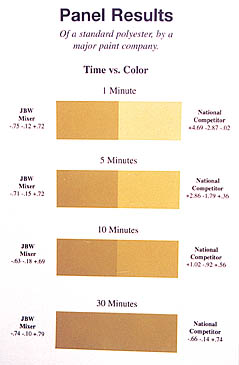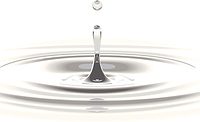Mixer Creates an Impression Without Making Waves

The Mixing System
The JBW Mixer is becoming an increasingly popular choice for mixing in drums and totes in the coating industry. The mixer is well-built, easy to set up and easy to maintain.James Watkins, president and CEO, is the inventor and patent owner of this mixing system. "When I first started manufacturing and selling the JBW Mixer, I would go into the customers' facility and set the mixer up to demonstrate how well it could mix a drum of paint," he said. "I remember setting up the mixer, turning it on, and after about two minutes, there would be a look of skepticism on the faces of the line personnel. They were watching for splashes and splatters. Invariably someone would point out, "Hey, this thing can't mix this drum of paint. It isn't even making waves." I would ask for another minute after which, skepticism quickly gave way to amazement when the product met all the specifications without making splashes, splatters and waves."
Watkins explains that when paint is being mixed, there should be very little surface movement. Surface movement can mean air entrapment. Yet customers believed that if the surface wasn't moving, it wasn't mixing. In reality for a mixer to be more effective, it should begin the mixing process by lifting the heavier and more costly elements off the bottom of the container.
Watkins designed the JBW Impeller to operate like a pump. The JBW Impeller is made of 316L stainless steel. It is conical in appearance with a solid top and five curved veins. When the mixer is operating the impeller rotates so that the veins do not cut into the coating product; instead the impeller veins operate like an airplane wing creating a 'flow' of paint over the veins - thus creating a lift from the bottom of the container and low-shear.
Traditional mixers begin the mixing process from the top down; however, customers pump the paint from the bottom of the container. The mixing system lifts the settlement from the bottom of the container where the mixing process is most needed for those who pump from there. This means that by using the JBW Mixer, users will save money by reducing scrap material, there is less downtime, there is less overtime, service calls are reduced, and there are fewer "finished" product claims. The mixer accomplishes this through superior agitation.
Maintenance is simplified since there are only four major parts to the mixing system. The JBW Drum Mixer consists of a 4-HP air motor that is complete with hardware, ready to attach to an air line; the Fugitive Emission Reduction Cover (FERC), which attaches to the container, has two flaps for easy access into the container and is made of extruded aluminum; the 1-inch-solid 316L stainless steel shaft; and the JBW Impeller made of 316L stainless steel. The mixer weighs less than 50 lbs, which makes it portable. It is adaptable and can be changed into a tote mixer by adding a counter-clockwise impeller and an 8" shaft extension. It can be designed to meet most customers' specifications.
Problem Solving
As soon as an order of paint is loaded on the truck for shipment to the customer, the settling process begins. The paint product is exposed to varying temperatures; it is known that temperature will affect viscosity very quickly. When the viscosity is affected the heavier elements begin to settle. However, it is the truck ride itself that begins most of the settling process. Settling is caused by many factors, including the following.
Any one or a combination of these factors will create problems with the finished product if the coating is not properly agitated. The customers' problem may not always be identified as "poor agitation" because their line personnel are skilled and knowledgeable enough to correct some problems by adjusting the oven temperature, roll speeds, line speeds, etc. However, when adjustments are made to the line, productivity is lost and other problems will be created later. With the use of the JBW Mixer there is no settlement left on the bottom of the drum. The product is agitated so that the same specs are met before the truck ride to the customers' facility. In most cases, if the product is mixed using the JBW Mixer, it requires 1-5 minutes of agitation for a 55-gal drum of product to meet specs. This can only lead to savings for the costly paint line time.
Some of the problems coaters may have to deal with due to poor agitation (which leaves pigment in the container) would be: poorer coverage than spec'd, gloss problems, color problems, and physical properties, i.e., pencil hardness, impact, T-Bend, fish eyes, and craters.
In order for a coater to adjust the coverage problem film thickness must be increased. When film thickness is increased this may create other problems; then further adjustment may be required. In the end productivity is reduced. When a coater sees the development of gloss and color problems, line personnel may begin adjusting the line speed and temperature. This may correct the gloss and color problem but productivity will be affected.
Within some of the physical properties mentioned above, fish eyes and craters specifically, are usually created with either air borne contamination or by using a mixing system that uses a gear reducer. Eventually a seal in the gear reducer will begin to leak and the oil will drip into the coating product. The JBW FERC was designed to prevent most air borne contamination and the direct drive air motor does not have a gear box to leak.
Poor agitation at the customer's facility, and the results of poor agitation, may be back-charged to the paint company for scrap and line time. The paint may be returned to the paint manufacturer to be reworked. At the paint manufacturer (internally) with their own mixing process, tint bases should be agitated and strength controlled. If there is poor agitation the tint strength changes. This will invariably create problems in tinting batches.
Many paint company's today are choosing to go to an enter-mix system to reduce the time from receipt of the order to the shipment of the order. It is critical that all the base colors be agitated and maintained for 'same' strength from top to bottom of the drum. Again this is where the JBW Mixer is being used successfully by providing the best possible agitation for these applications.
Many coaters are also choosing to have an on-site enter-mix system in order for them to blend a product quickly. This allows them the opportunity to satisfy their customers and have the finished product ready within hours. Many coaters are now using the JBW Mixing System for their enter-mix system.
When Watkins began selling the JBW Mixer, he offered to demonstrate the performance at the customer facility. The customer would invariably bring out an old drum of paint that had been set aside for a period of time. In every case, the JBW Mixer mixed the paint back to specifications within minutes. It was a perfect time for Watkins to explain that the old drum of paint would never cost the company a pound of scrap because every effort necessary to make the paint right would be taken before it gets near the paint line. What will cost productivity would be the most recent order of paint in a standard color, because drum number five and drum number eight might not settle at the same rate as the others. This is where the JBW Mixer could save the company money with fast, even agitation that pulls from the bottom of the drum and lifts up the heavy, high-cost pigments, dispersing them back into the liquid solution for even and full coverage.
When a customer purchases paint, the percentage of the solids is what determines the cost. If these solids are left on the bottom of the container, the color, gloss and viscosity are adversely effected and other important factors may be off. By leaving these solids in the container, the customer is leaving part of his money on the bottom of the drum and making less profit.
While huge amounts of funds are put into updating a paint line to the "latest" technology, mixing is many times overlooked and largely ignored. Proper mixing reduces scrap, downtime, overtime, claims and ultimately "improves the bottom-line." The JBW Mixing System was designed specifically to cover most customers' mixing needs.
For more information on mixing systems, or to obtain a list of customers, contact James R. Watkins, JBW Systems Inc., 106 E. College Ave., Westerville, OH 43081; phone 614/882.5008; fax 614/882.5004; e-mail jbwsystems@msn.com; visit www.jbwsystems.com; or Circle Number 95.

Birth of the JBW Mixing System
James R. Watkins, president and CEO, has 36 years of experience in the coil coating industry. Watkins started his career in the mid-1960s at PPG in Delaware, OH. At that time, the facility manufactured container, appliance, auto refinish and coil coatings products.At PPG Watkins worked almost exclusively with coil coating products. His responsibilities included checking new formulas for accuracy and feasibility, checking existing formulas for possible raw material changes to improve quality, and checking for the final quality control of products in-house, as well as at the customers' facility.
Watkins' comprehensive knowledge of coating technology created an awareness of the importance of good agitation. He would call on coaters who were having line problems and noted that many of the problems could have been avoided if the customer had used a mixer that mixed the paint better.
Over the years, Watkins had plenty of opportunity to observe mixers while they were in use. He noted that most of the drum mixers available seemed to mix with a flat blade that left the pigments on the bottom of the drum. As early as 1975, he began thinking of an idea for a better mixing system. One of his good friends was a retiree from a pump manufacturer. When they would get together, invariably the discussion would center on Watkins' idea for new mixing technology. Through these discussions, Watkins began to develop a mixer design. He wanted the mixer to be the answer to the problems that he saw every day in the coating facilities. He left PPG and began working for Parker Chemical in the early 1980s and his ideas were put on the back burner.
The opportunity to develop a prototype for the JBW Mixing System finally came about in 1990. He had several goals in mind for his mixer. He wanted it to be made of the finest materials yet be inexpensive, to mix faster and better, to mix from the bottom of the container, to be adaptable for drums and tote containers, and to be lightweight so as to remain portable. He knew if he could design his mixer to be capable of accomplishing all these goals that it would help coaters to achieve their goals and create less problems for paint manufacturers.
Watkins put his idea on paper for the first time and began the first stage of building his mixer with the design of the JBW Impeller. He had several impellers manufactured and began calling on customers that he had forged a working relationship with from his days at PPG and Parker Chemical. In a matter of months, word spread and orders began pouring in.
It was obvious that customers were excited about his impeller design when they began offering suggestions for a complete mixing system. Watkins noted that there were other concerns in the industry that he could address with his mixer and he began to design a "complete" mixing system -the JBW Mixing System. Later with the development of the JBW Tote Mixing System the mixer name was shortened to the JBW Drum Mixer and/or the JBW Tote Mixer, respectively.
Government regulations were increasingly affecting the coating industry, such as the EPA's concern about fugitive emissions, OSHA's request that all moving shafts be shrouded, and equipment that is to be lifted over shoulder height should be less than 50 lbs. Even the insurance industry had an impact due to the fact that they saw a drum of paint as fuel in the event of a fire.
Watkins decided his mixing system had to include a lid to cover the container. His complete prototype mixer was developed with a 4-HP air motor mounted on top of a drum cover, with a 4" square hinged flap so that the customer could look in and check on the mixing process.
Watkins realized that the drum lid design was not going to be sturdy enough for the strength (or pull) of his mixer and it didn't fit his requirement that the mixing system be made of the 'finest' material. Just months after the first sale of the JBW Impeller, Watkins began working on a design for the drum lid which led to the development of the Fugitive Emission Reduction Cover (FERC).
The FERC is made of extruded aluminum. It is then machined and buffed to a soft finish. The finished product is very impressive. Bolt holes are machined into the center section to mount the 4-HP air motor. Two flaps are extruded and fitted in place on either side of the centerpiece. They are hinged so that they can be lifted up for insertion of pumps and/or other items into the container. These flaps can be quickly snapped down so that the FERC totally covers the top of the container.
Watkins didn't stop there. He decided to supply the mixing system with hardware attached to the 4-HP air motor so that when the mixer is received minimum preparation is required. The JBW Mixer arrives in two pieces and is assembled simply by attaching the 1-inch-solid stainless-steel shaft to the motor. All that is then required is to put the mixer in the container, fasten the T-clamps, and attach the air supply.
Links
Looking for a reprint of this article?
From high-res PDFs to custom plaques, order your copy today!





